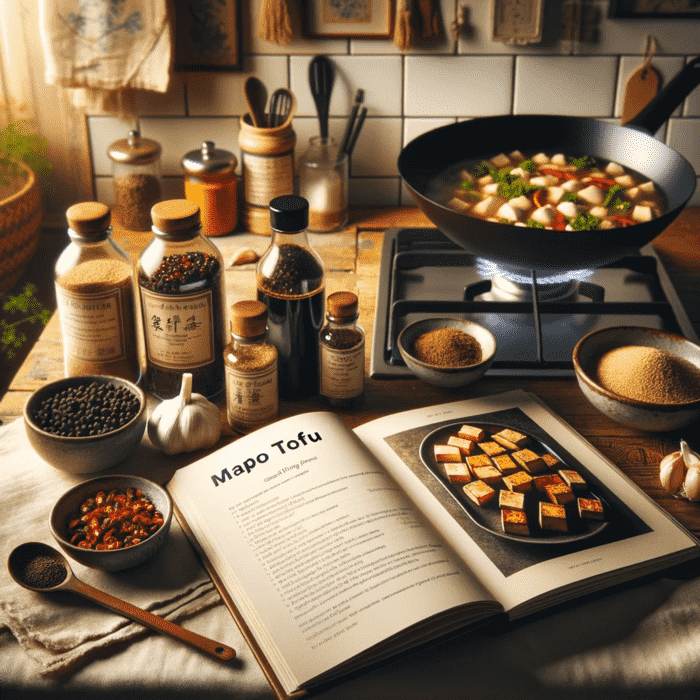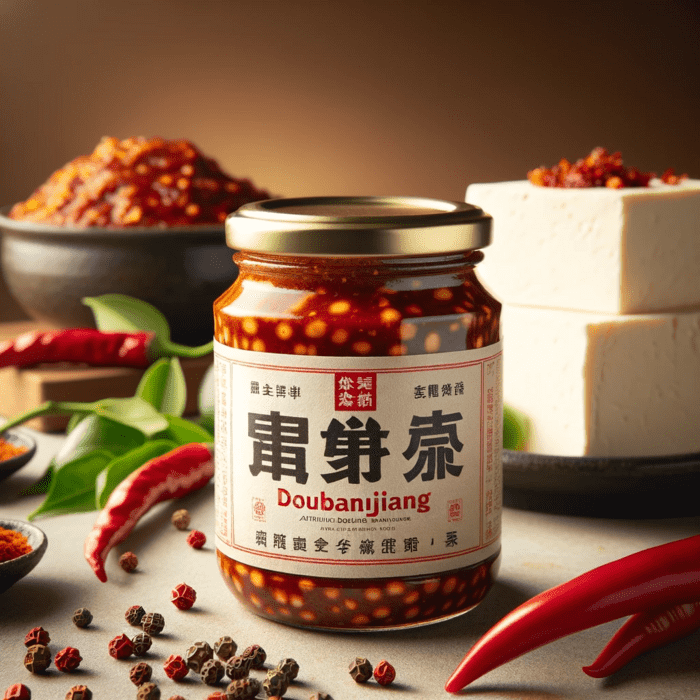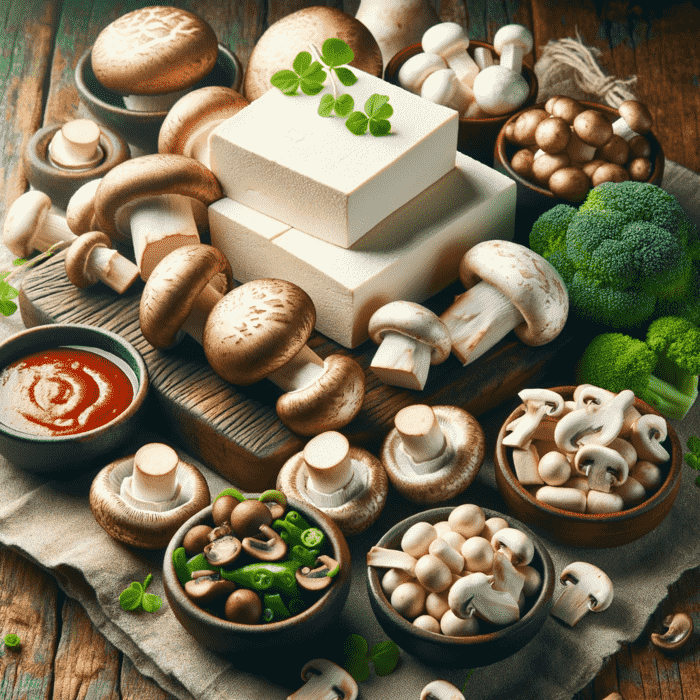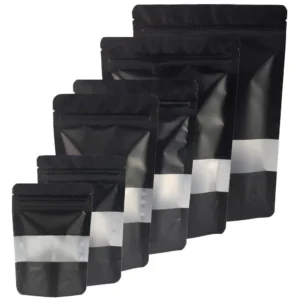Introduction
Welcome to the tantalizing world of mapo tofu, a fiery and flavorful Chinese dish that has captured the hearts (and taste buds) of food enthusiasts worldwide. This beloved Sichuan specialty is known for its bold and spicy flavors that leave a lasting impression.
With a rich history dating back to the Qing Dynasty, mapo tofu carries cultural significance as it represents the vibrant culinary heritage of Sichuan province. The dish’s name translates to “pockmarked old lady’s tofu,” paying homage to its creator, an elderly woman with pockmarks on her face. Today, mapo tofu continues to be celebrated for its complex blend of numbing Sichuan peppercorns, savory bean paste, tender tofu cubes, and aromatic spices.
Key Ingredients: Authentic Doubanjiang for Traditional Mapo Tofu

To create an authentic and flavorful mapo tofu, one of the key ingredients you need is doubanjiang. This fermented chili bean paste adds a depth of flavor and complexity to the dish that sets it apart from other spicy dishes. Let’s explore why using authentic doubanjiang is crucial for achieving that traditional taste.
Importance of Using Authentic Doubanjiang
Using authentic doubanjiang is essential because it brings out the true essence of mapo tofu. It carries a distinct umami flavor with a balance of spiciness and saltiness, which elevates the overall taste profile. The use of high-quality doubanjiang ensures that your mapo tofu has that signature kick and richness.
Depth and Complexity in Flavor
Doubanjiang contributes to the bold and spicy flavors found in mapo tofu. Its fermentation process enhances its taste, creating a savory depth that harmonizes with other ingredients. The combination of chili peppers, soybeans, and spices in this bean paste creates a symphony of flavors that tantalize your taste buds.
Choosing the Best Doubanjiang
When selecting doubanjiang for your recipe, consider the different types available. Some options include Pixian doubanjiang, Chuanbaizhi doubanjiang, or Hongyou douganjian. Each type offers its unique characteristics and heat levels, allowing you to tailor the spice level according to your preference.

Other Essential Ingredients
In addition to doubanjiang, several other key ingredients contribute to the distinctive taste of mapo tofu. These include soy sauce for saltiness, garlic for pungency, ginger for warmth, green onions for freshness, and oil for food images. Together, they create a symphony of flavors that dance on your palate.
Marinating Meat for Enhanced Flavor and Texture
Marinating meat is the secret to achieving tender and flavorful mapo tofu that will leave your taste buds begging for more. Whether you’re using ground pork or beef, properly marinating the meat can take your dish to the next level.
To begin, gather your raw meat of choice, such as ground pork or beef. In a bowl, combine soy sauce, rice wine, cornstarch, and other seasonings to create a delicious marinade that will infuse the meat with flavor. The soy sauce adds a savory umami taste to the food, while the rice wine helps tenderize the meat.
Once you’ve mixed all the ingredients together, add the raw meat into the marinade. Make sure every piece is coated evenly for maximum flavor absorption. Allow it to marinate for at least 30 minutes to allow the flavors to penetrate.
During this time, you can prepare other components of your mapo tofu dish like chopping vegetables or making the sauce. The longer you marinate the meat, the more intense and flavorful it will become.
After marinating, remove any excess marinade from the meat before cooking it in a hot pan or wok.
Perfecting the Sauce: Achieving Optimal Thickness with Starch Water
The savory food sauce is what brings all the flavors together. Achieving the perfect consistency for the sauce is crucial in creating a delicious dish. One key ingredient that plays a vital role in achieving optimal thickness is starch water.
Understand the Role of Starch Water
Starch water acts as a thickening agent in the mapo tofu sauce. It helps bind all the ingredients together and gives the sauce its desired texture. By dissolving cornstarch or potato starch in water without forming lumps, you can create starch water that will enhance your sauce.
Making Starch Water
To make starch water, simply dissolve cornstarch or potato starch in cold water. The ratio should be one part starch to three parts water. Stir well until there are no lumps remaining. You can adjust the amount of starch according to your preference for thickness.
Adjusting Sauce Thickness
If you find that your sauce is too thin, you can add more starch water gradually while stirring continuously. On the other hand, if your sauce is too thick, you can dilute it by adding small amounts of chicken stock or soaking water from dried mushrooms.
Incorporating Starch Water into Simmering Sauce
To incorporate starch water into your simmering sauce, sprinkle it gradually over the surface while stirring continuously. This prevents clumping and ensures even distribution throughout the sauce. Keep stirring until you achieve your desired thickness.
Cooking Tips: From Blanching Tofu to Thickening Sauce

Blanching tofu is a crucial step that can elevate the texture and flavor of your mapo tofu recipe. By briefly boiling the tofu before cooking, you remove any raw or beany taste while also firming up its structure. This helps prevent the tofu from crumbling during the cooking process, allowing it to retain its shape and absorb more of the flavorful sauce.
To blanch tofu, simply bring a pot of water to a boil and gently slide in the cubed tofu. Let it cook for about 2-3 minutes until it becomes slightly firm. Then, carefully remove the tofu from the boiling water using a slotted spoon or tongs.
You have control over two key ingredients: chili oil and Sichuan peppercorns. If you prefer a milder dish, reduce the amount of chili oil or use a milder variety. On the other hand, if you’re looking for an extra kick, feel free to increase the amount. Similarly, Sichuan peppercorns add numbing heat to mapo tofu, so adjust their quantity according to your preference.
Thickening the sauce in your mapo tofu without overpowering other flavors can be achieved by using starch water. Starch water is created by dissolving cornstarch or potato starch in cold water before adding it to your sauce mixture towards the end of cooking. This technique helps thicken the sauce without altering its taste significantly.
Vegetarian/Vegan Adaptations for Mapo Tofu Recipe
Looking to enjoy the flavors of mapo tofu but prefer a vegetarian or vegan option? No worries, there are plenty of delicious adaptations that replace the meat with plant-based alternatives. Let’s explore some mouthwatering options!

Plant-Based Substitutions for Meat
Instead of using traditional ground pork or beef in your mapo tofu recipe, you can try substituting it with plant-based alternatives like mushrooms, seitan, or tempeh. These ingredients provide a similar texture and umami taste that complements the dish perfectly.
Maintaining Texture and Umami Taste
One concern when making vegetarian or vegan mapo tofu is maintaining the signature texture and rich umami flavor. To achieve this, make sure to use mushrooms that have a meaty texture like shiitake or oyster mushrooms. Seitan and tempeh also offer a chewy consistency that mimics meat.
Spice Levels and Variations
Mapo tofu is known for its spicy kick, but you can adjust the heat level according to your preference. Experiment with different chili sauces or powders to find the perfect balance of spiciness. You can add other seasonings like Szechuan peppercorns for an extra layer of flavor.
Adding Extra Vegetables
To make your vegetarian/vegan mapo tofu even more nutritious and flavorful, consider adding additional vegetables into the mix. Some popular choices include bell peppers, carrots, snap peas, or baby corn. These veggies not only enhance the visual appeal but also contribute to a well-rounded meal.
Sichuan Peppercorns: The Secret Spice in Mapo Tofu
Sichuan peppercorns are the secret ingredient that adds a unique numbing and tingling sensation to the beloved dish of mapo tofu. These tiny red berries pack a punch, giving mapo tofu its distinctive flavor profile.
Uncover the Unique Sensation
When you take a bite of mapo tofu seasoned with Sichuan peppercorns, get ready for a rollercoaster ride of flavors. The peppercorns provide a numbing sensation on your tongue, followed by a subtle tingling feeling that lingers. It’s an experience like no other!
Types of Sichuan Peppercorns
There are different types of Sichuan peppercorns available, each with its own level of heat and aroma. Common varieties include:
• Red Sichuan peppercorns: These have a strong aroma and intense heat.
• Green Sichuan peppercorns: They offer a milder flavor and are less spicy.
• Mixed Sichuan peppercorns: This blend combines both red and green varieties for a balanced taste.
Toasting and Grinding Techniques
To maximize the flavor impact of Sichuan peppercorns in your mapo tofu, it’s essential to toast and grind them properly. Here’s how:
1. Toasting: Heat the peppercorns in a dry pan over medium heat until fragrant.
2. Grinding: Use a mortar and pestle or spice grinder to crush the toasted peppercorns into coarse flakes.
Balancing Spiciness with Numbing Effect
Mapo tofu is known for its spiciness, but it’s crucial to strike the right balance between chili peppers’ heat and the numbing effect of Sichuan peppercorns. Adjust the amount of pepper flakes according to your preference, keeping in mind that too much can overpower the dish.
Now that you understand the role of Sichuan peppercorns in mapo tofu, get ready to elevate your culinary skills and create a mouthwatering dish that will leave your taste buds buzzing!
Embrace the Fiery Charm of Homemade Mapo Tofu

Master the Art of Homemade Mapo Tofu
If you’re a fan of spicy and flavorful dishes, then mapo tofu is a must-try! This classic Chinese dish made with soft tofu, ground meat, and a fiery chili sauce is known for its bold flavors and tongue-tingling heat. But why settle for restaurant versions when you can master the art of preparing homemade mapo tofu that surpasses their quality?
Adjust Spice Levels to Suit Your Taste
One of the great things about making your own mapo tofu is that you have full control over the spice levels. Whether you prefer a milder version or crave an extra kick, feel free to experiment with adjusting the amount of chili paste or chili oil according to your personal preference. This way, you can create a customized mapo tofu that perfectly suits your taste buds.
Create a Flavorful Dish from Scratch
Preparing homemade mapo tofu allows you to enjoy the satisfaction of creating a flavorful dish from scratch. By using fresh ingredients like silken tofu, ground meat, garlic, and authentic seasonings such as Sichuan peppercorns and fermented black beans, you can elevate the taste profile of your mapo tofu to new heights. The combination of these ingredients creates a symphony of flavors that will leave your taste buds craving for more.
Impress with Bold and Spicy Flavors
Imagine serving your family and friends a homemade mapo tofu that bursts with bold and spicy flavors. Not only will they be impressed by your culinary skills but also delighted by the explosion of tastes in every bite. By following traditional recipes or adding your own twist to this beloved dish, you can showcase your creativity in the kitchen while satisfying everyone’s cravings for delicious food.
Conclusion
Through the tantalizing world of mapo tofu, uncovering its secrets and learning how to create this bold and spicy delight in your own kitchen. Now, armed with knowledge about key ingredients like authentic Doubanjiang, marinating techniques for enhanced flavor, perfecting the sauce’s thickness with starch water, cooking tips from blanching tofu to thickening the sauce, vegetarian/vegan adaptations, the magic of Sichuan peppercorns, and embracing the fiery charm of homemade mapo tofu; you’re ready to embark on a culinary adventure that will leave your taste buds dancing.
FAQs
Can I adjust the spice level in mapo tofu?
Absolutely! Mapo tofu is known for its fiery kick, but you can easily adjust the spice level according to your preference. Simply reduce or increase the amount of Doubanjiang and Sichuan peppercorns used in the recipe. Remember to taste as you go along so that you can find your perfect balance between heat and flavor.
Can I substitute Doubanjiang with another chili bean paste?
While Doubanjiang is traditionally used in mapo tofu for its unique flavor profile, if you can’t find it locally or prefer a different chili bean paste, feel free to experiment. Look for alternatives like Korean gochujang or Japanese miso paste mixed with chili flakes. Keep in mind that the taste may differ slightly, but it can still result in a delicious dish.
Can I use firm tofu instead of silken tofu?
Certainly! While silken tofu is commonly used in mapo tofu for its delicate texture, you can opt for firm tofu if you prefer a more substantial bite. Just be careful when stirring to avoid breaking the tofu into small pieces. The choice between silken and firm tofu ultimately depends on your personal preference.
Is mapo tofu suitable for vegetarians or vegans?
Absolutely! Mapo tofu can easily be adapted to suit vegetarian or vegan diets. Simply omit the meat and use vegetable broth instead of chicken broth. Ensure that all other ingredients are vegan-friendly, such as using mushroom sauce instead of oyster sauce. With these simple substitutions, you can enjoy a flavorful and satisfying vegetarian or vegan version of this classic dish.
Can I make mapo tofu ahead of time?
Mapo tofu is best enjoyed fresh off the stove when its flavors are at their peak. However, if you have leftovers or need to prepare in advance, you can store it in an airtight container in the refrigerator for up to three days. Reheat gently on the stovetop or in the microwave until heated through before serving.
Frequently Linked Pages
1. Kung Pao Chicken – Kung Pao Chicken Recipe: Spicy Delight!
2. Dumplings Near Me – Dumplings Near Me: Best Deals & Delivery Options
3. Chop Suey – Chop Suey: A Delicious Culinary Adventure In Every Bite
4. Wonton – Wonton Making: The Ultimate Guide
5. Peking Duck – Peking Duck Recipe: Easy Home Version
6. Chinese Food – Chinese Food: A Gastronomic Adventure into Authentic Oriental Flavors
7. Chow Mein – Chow Mein: A Flavorful Exploration of the Classic Chinese Stir-Fried Noodles
8. Sashimi – sashimi: A Guide To The Delicate Art Of Raw Seafood







